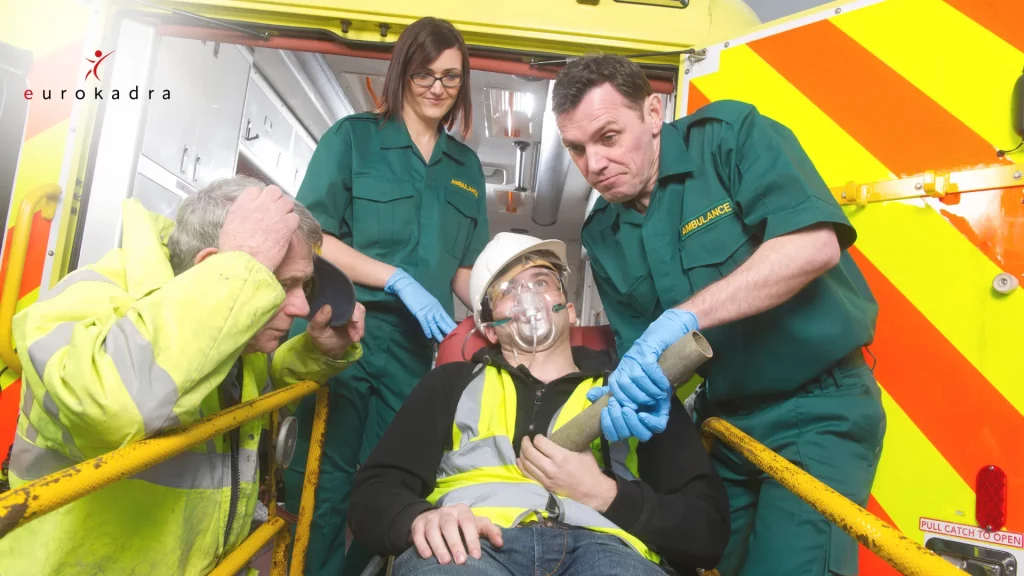Safety at work – how to take care of it?
Ensuring safety at work is one of the most important duties of the employer. Effective protective measures and adherence to proper practices are the foundation of a healthy and productive work environment. How to ensure security in the company? How to easily increase the level of safety at work? What is the penalty for breaking health and safety regulations?

CONTENTS:
- Health and safety rules – legal basis
- Basic obligations of the employer
- Duties and rights of the employee
- Basic health and safety rules – how to ensure safety at work?
- Why are health and safety rules important?
- What is the penalty for breaking health and safety regulations?
Health and safety rules – legal basis
The rules of occupational health and safety are defined in the Regulation of the Minister of Labor and Social Policy of September 26, 1997 on general occupational health and safety regulations. The legal basis may also be other laws, such as:
- Fire Protection Act
- Act on the National Labor Inspectorate
- Food and Nutrition Safety Act
- Regulation on: dangerous work, arduous work or work harmful to the health of pregnant women and women who are breastfeeding.
Basic obligations of the employer
The provisions of the Labor Code say that the employer:
- He is responsible for a safe workplace in his plant. It must protect the life and health of its employees and provide them with appropriate conditions.
- It must inform about the observance of safety rules and issue penal orders in case of violation of health and safety regulations.
- It must provide occupational health and safety training, which will present: occupational safety culture, occupational hazards, occupational health and safety standards, occupational health and safety instructions, occupational risk, preventive health care.
- It must ensure a coherent policy to prevent accidents at work and occupational diseases.
- It must take into account the protection of the health of young people, pregnant or breastfeeding employees and disabled employees as part of the preventive measures taken.
- It must ensure the execution of orders, statements, decisions and orders issued by the authorities supervising working conditions.
- It should bear the costs of activities related to increasing security and should not burden employees with this.
- He is obliged to provide employees with information about threats to health and life, about actions in the field of fighting fires and evacuation of employees, about the principles of first aid.
- He is obliged to provide the means necessary to provide first aid, ensure communication with external services.
Duties and rights of the employee
It’s not just the employer who has to comply with the law. Employee responsibilities are also important to ensure a safe workplace. The provisions of the Labor Code say that an employee:
- He should know all the basic health and safety rules at work and take care of common safety in the company.
- He must perform his work in accordance with the regulations and safety rules.
- Take care of the proper condition of machines, tools and devices as well as order in the workplace.
- Must use collective protection measures, including protective clothing, work shoes.
- He must do periodic and control medical examinations and follow the doctor’s instructions.
- He must promptly notify the employer of an accident or a threat to life and health.
- Must cooperate with the employer in meeting health and safety obligations.
Also read: Mobbing at work

Basic health and safety rules – how to ensure safety at work?
Ensuring health and safety at work is a key responsibility of every employer and employee. There are a number of laws and regulations to protect your health and ensure a safe working environment. How to ensure safety at work?
- Compliance with health and safety rules – understanding and complying with the rules of occupational health and safety is fundamental. This includes wearing the right protective equipment, following safety procedures, and avoiding risky behavior.
- Participation in training – regular participation in OHS training allows you to gain knowledge about the risks and how to avoid them. Training should cover industry- and job-specific areas.
- Occupational risk assessment – employers should conduct regular workplace risk assessments, identifying potential hazards and developing strategies to minimize them.
- Workplace – the employer should provide a clean and safe working environment and conditions adapted to the psychophysical needs of the employee.
- Using the right equipment and tools – Using tools and equipment as intended and in good working order is key to avoiding accidents.
- Proper Storage and Labeling of Hazardous Substances – If chemicals or other hazardous materials are used at work, they must be properly stored and labeled in accordance with regulations.
- Prepare for emergencies – knowing the procedures to follow in the event of an emergency or dangerous situation is crucial. This should also include knowledge of the location of firefighting equipment, emergency exits and assembly points.
- Regular technical inspections – equipment and machines should be regularly checked and serviced to ensure their efficiency and safety of use.
- Reporting Potential Hazards – Employees should be encouraged to report any situations or conditions that may pose a safety hazard in the workplace.
- Work safety culture – building an organizational culture in which safety is a priority, fosters mutual care and responsibility for safe working conditions.
- Compliance with the employer’s instructions – it is very important to avoid work hazards and maintain safety in the company.
- Medical examinations – for some jobs, a doctor’s certificate is required, which assesses whether there are any contraindications to perform a given job.
- Signs in the workplace – in every workplace there is an obligation to post signs informing, prohibiting, ordering and warning. Each of the employees must adapt to them.
- Order in the workplace – each employee should take care of it so as to reduce the risk of an accident. Any trip hazards or spills must be removed immediately.
- The way to and from work – the basic principles of health and safety at work also apply outside the workplace.

Why are health and safety rules important?
Compliance with the regulations is very important to increase the level of safety in the workplace. They have a key impact on the health, life and efficiency of employees. Compliance with these principles is the primary responsibility of both employers and employees. Thanks to them, the risk of accidents and life threats is reduced, which affects the protection of employees’ health.
What is the penalty for breaking health and safety regulations?
Violation of health and safety regulations results in penalties imposed by the employer. He may apply admonitions, reprimands, fines or non-pecuniary disciplinary penalties. The fine for one offense may not be higher than one day’s wages. In total, the fines may not exceed 10 of this part of the remuneration.
If the employer fails to comply with the safety regulations, he or she is subject to an offence, the amount of which may range from PLN 1,000 to PLN 30,000. When an employee is injured, the employer must ensure that he is compensated. The employee may demand compensation for the harm suffered. In the event of an employee’s death caused by the employer or another person who did not comply with the health and safety rules, the employee is liable to imprisonment for up to 3 years. If the perpetrator acted unintentionally, he is subject to a fine, restriction of liberty or imprisonment for up to one year.
Occupational health and safety are one of the most important principles to be followed in the workplace. It is not only an obligation, but also an investment in the health of everyone involved in a given job. let us remember that taking care of safety in the workplace is a long-term process that requires commitment, education and continuous improvement of practices. Through common care and compliance with health and safety rules, we create conditions conducive to health, safety and success in our daily professional activities.
Read also: Working in the heat – what obligations does the employer have?
 Back
Back